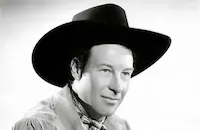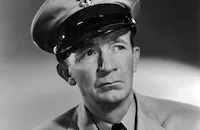Murder in the Clouds

Brief Synopsis
Cast & Crew
D. Ross Lederman
Lyle Talbot
Ann Dvorak
Gordon Westcott
Robert Light
George Cooper
Film Details
Technical Specs

Synopsis
Three Star Bob Halsey is a wild pilot who loves flying stunts. He is in love with stewardess Judy Wagner, but she refuses to marry him until he settles down. Judy is, therefore, a little upset when her brother Tom tells her that he has gotten a job as Bob's co-pilot. When Lackey, the head of the airport, is asked to assign someone to fly a top secret formula for a new explosive along with its inventor to Washington, D. C., he assigns Bob and Tom. Unknown to him, the conversation is overheard by spy Jason, who telephones fellow agent Taggart with the information. Just before the flight, Bob goes into a nearby bar for a soft drink, and three men pick a fight with him, knocking him out. When he does not show up at the airport on time, another pilot, George Wexley, offers to take the plane up with Tom. Soon after takeoff, the plane explodes, killing all on board. Government agents search the crash area for the cylinder containing the formula, but they cannot find it. Bob and Lackey fly to the crash site to aid in the search, but Bob only finds Tom's hat. Judy, who is waiting at the airport, grows impatient for news and drives up to the site. She is not allowed to pass, but takes a back road, stopping at a house up the road. By chance she has found Taggart's hideout, where Jason and Wexley are staying. Wexley tells Judy that Tom parachuted out of the airplane along with him and is now in Mexico where she can meet him. He plans to attach the cylinder to her car so that she will innocently smuggle the cylinder out of the country. Meanwhile, Wings Mahoney, another pilot, tells Bob that Judy left to meet him, and then Bob learns that Jason was involved somehow in the crash. Bob and Lackey search Jason's office and find the listening device. While this is going on, Judy overhears a radio report of the accident, and realizes that Wexley has been lying to her. She pretends not to have heard the news, and that night, paints a message on the roof of the house. Flying over the crash site, Bob and Wings see Judy's sign, and land the airplane nearby. Leaving Wings at the controls, Bob sneaks into the house and rescues Judy, but is seen by one of the men. Bob and Judy rush to the airplane, but Wings panics and flys away without them. While Wings is trying to bring the government agents, Wexley escapes in another airplane with Judy and the formula. The agents finally arrive, and with Bob's help, ground Wexley's airplane and rescue Judy and the formula. Judy and Bob get married.

Director

D. Ross Lederman
Cast

Lyle Talbot

Ann Dvorak
Gordon Westcott
Robert Light
George Cooper
Charles Wilson

Henry O'neill

Russell Hicks

Arthur Pierson

Edward Mcwade

Clay Clement
Eddie Shubert

Wheeler Oakman
Nick Copeland
Harold Entwistle
Harry Tyler

Tom Wilson
Joe Bordeaux
Joseph E. Bernard
Lester Dorr
Selmer Jackson
Eddy Chandler
Cliff Saum
Milton Kibbee
Georgie Cooper

Gordon Elliott
Ray Brown

Walter Brennan
Crew

Film Details
Technical Specs

Articles
Murder in the Clouds
The script teamed freelance writer Dore Schary, who was averaging $250 a script at the time, with studio writer Roy Chanslor. It re-cycled a typical Warner's plot - a carefree hero whose excesses discredit him until he saves the day in the end. This time, instead of a soldier, federal agent or college athlete, the hero is an airplane captain and his problem is a weakness for gambling. Schary wrote this shortly after being fired from MGM, a daredevil habit of his own (he would be fired from MGM three times, the last after six years as production head). Because of his ability to write quickly and effectively, he had no trouble supporting himself with freelance assignments like this.
Lyle Talbot's presence at the top of the cast list is a sure indicator that this was intended as a B film. The veteran of stage and vaudeville had found work easily in the early days of talking pictures, but he rarely made it beyond supporting roles in A pictures. Eventually, he would spend most of his career in B movies, though that gave him the chance to become the screen's first Commissioner Gordon (in the 1949 serial Batman and Robin) and the first Lex Luthor (in another serial, Superman vs. the Atom Man [1950]). Eventually he would become a regular performer in Ed Wood's poverty row-classics, including Glen or Glenda (1953) and Plan 9 from Outer Space (1959). One reason for his move into low-budget production may have been his prominent role in the creation of the Screen Actor's Guild. A frequent agitator for better working conditions, Talbot was the first contract player at Warner's to join the new union.
Equally rebellious was leading lady Ann Dvorak. A prominent figure in early talkies, particularly as Paul Muni's doomed sister in Scarface (1932), Dvorak had started out as one of Warner's top leading ladies. But when she found out the child actor playing her son in Three on a Match (1932) was making as much as she, she raised a ruckus. She also complained about the many pedestrian productions she had to do for each solid role, and before long was eclipsed by another Three on a Match co-star, the equally feisty Bette Davis. By the time she left Warner's in the late '30s, Dvorak roles were getting smaller, along with the budgets of most of her films.
Of course, the real star of Murder in the Clouds was Elmer Dyer, an accomplished aerial photographer who had worked on the original version of The Dawn Patrol (1930). His flight sequences were so spectacular that one actually precedes the film's titles, a rarity in '30s films. Never known to use a good sequence only once, Warner's would recycle the flight scenes from Murder in the Clouds in later B films about aviation.
Producer: Samuel Bischoff
Director: D. Ross Lederman
Screenplay: Roy Chanslor, Dore Schary
Cinematography: Warren Lynch
Music: Ray Heindorf, Bernhard Kaun
Art Direction: Jack Holden
Principal Cast: Lyle Talbot (Bob 'Three Star' Halsey), Ann Dvorak (Judy Wagner), Gordon Westcott (George Wexley), Robert Light (Tom Wagner), George Cooper (Wings Mahoney), Henry O'Neill (John Brownell).
BW-61m.
by Frank Miller















